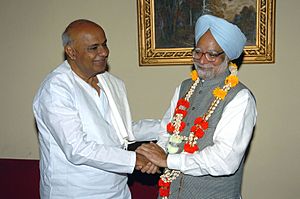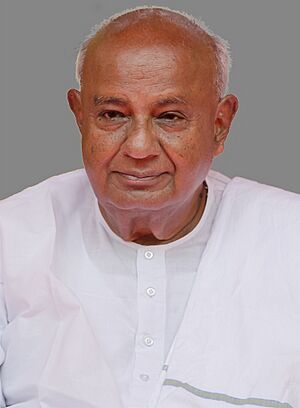H. D. Deve Gowda facts for kids
Quick facts for kids
H. D. Deve Gowda
|
|
|---|---|
 |
|
| Prime Minister of India | |
| In office 1 June 1996 – 21 April 1997 |
|
| President | Shankar Dayal Sharma |
| Vice President | K. R. Narayanan |
| Preceded by | Atal Bihari Vajpayee |
| Succeeded by | Inder Kumar Gujral |
| Union Minister of Home Affairs | |
| In office 1 June 1996 – 28 June 1996 |
|
| Prime Minister | Himself |
| Preceded by | Murli Manohar Joshi |
| Succeeded by | Indrajit Gupta |
| Member of Parliament, Rajya Sabha | |
| Assumed office 26 June 2020 |
|
| Preceded by | D. Kupendra Reddy |
| Constituency | Karnataka |
| In office 23 September 1996 – 2 March 1998 |
|
| Preceded by | Leeladevi Renuka Prasad |
| Succeeded by | A. Lakshmisagar |
| Constituency | Karnataka |
| Member of Parliament, Lok Sabha | |
| In office 17 May 2004 – 23 May 2019 |
|
| Preceded by | G. Puttaswamy Gowda |
| Succeeded by | Prajwal Revanna |
| Constituency | Hassan, Karnataka |
| In office 2 February 2002 – 16 May 2004 |
|
| Preceded by | M. V. Chandrashekara Murthy |
| Succeeded by | Tejashwini Sreeramesh |
| Constituency | Kanakapura, Karnataka |
| In office 10 March 1998 – 26 April 1999 |
|
| Preceded by | Rudresh Gowda |
| Succeeded by | G. Puttaswamy Gowda |
| Constituency | Hassan, Karnataka |
| In office 20 June 1991 – 11 December 1994 |
|
| Preceded by | H. C. Srikantaiah |
| Succeeded by | Rudresh Gowda |
| Constituency | Hassan, Karnataka |
| Chief Minister of Karnataka | |
| In office 11 December 1994 – 31 May 1996 |
|
| Governor | Khurshed Alam Khan |
| Preceded by | Veerappa Moily |
| Succeeded by | Jayadevappa Halappa Patel |
| Member of Karnataka Legislative Assembly | |
| In office 1994–1996 |
|
| Preceded by | CM Lingappa |
| Succeeded by | CM Lingappa |
| Constituency | Ramanagara |
| In office 1962–1989 |
|
| Preceded by | Y. Veerappa |
| Succeeded by | G. Puttaswamy Gowda |
| Constituency | Holenarasipur |
| President of Janata Dal (Secular) | |
| Assumed office July 1999 |
|
| Preceded by | Office established |
| Personal details | |
| Born | 18 May 1933 Haradanahalli, Kingdom of Mysore, British India |
| Political party | Janata Dal (Secular) (1999–present) |
| Other political affiliations |
|
| Spouse |
Chennamma
(m. 1954) |
| Children | 6 children; including H. D. Revanna and H. D. Kumaraswamy |
| Education | Diploma in Civil Engineering |
| Alma mater | L. V. Polytechnic, Hassan |
| Profession |
|
| Signature | |
| Nicknames | Mannina Maga Dodda Gowdaru |
Haradanahalli Doddegowda Deve Gowda (; born 18 May 1933) is an Indian politician. He served as the prime minister of India from 1996 to 1997.
Before that, he was the chief minister of Karnataka from 1994 to 1996. He has also been a Member of Parliament (MP) in the Lok Sabha. He is a member of the Janata Dal (Secular) party and has been its president since 1999. Since 2020, he has been an MP in the Rajya Sabha, representing Karnataka.
Deve Gowda grew up in a family of farmers. He joined the Indian National Congress (INC) party in 1953. He became the head of the Janata Dal party in Karnataka in 1994. He helped his party win the state elections that year. After serving as Chief Minister, he became Prime Minister in 1996. This happened because no single party won enough seats to form a government on its own. He led a group of parties called the United Front. His time as Prime Minister lasted less than a year. He left office in April 1997. After his time as Prime Minister, he continued to be a Member of Parliament in the Lok Sabha until 2019. In 2020, he was elected to the Rajya Sabha.
Contents
Early Life and Political Start
H. D. Deve Gowda was born on 18 May 1933. His birthplace was Haradanahalli, a village in what was then the Kingdom of Mysore. Today, this area is in the Hassan district of Karnataka. His father, Dodde Gowda, was a farmer who grew rice. His mother, Devamma, was a homemaker.
Deve Gowda studied civil engineering and earned a diploma from L. V. Polytechnic in Hassan in the early 1950s.

In 1953, Deve Gowda joined the Indian National Congress party. He stayed with the party until 1962. During this time, he was involved in local community groups. He was the President of the Anjaneya Cooperative Society of Holenarasipura. He also became a member of the Taluk Development Board of Holenarasipura.
Becoming Chief Minister of Karnataka
Starting in State Politics
In 1962, Deve Gowda was elected to the Karnataka Legislative Assembly. This is like the state parliament. He was elected from the Holenarasipura area as an independent candidate. He was re-elected from the same area for six terms in a row, from 1962 to 1989. He later joined the Congress (O) party when the main Congress party split. He also served as the Leader of the Opposition in the Legislative Assembly. This means he was the main leader of the parties not in power. During a period called "The Emergency" in the 1970s, he was put in jail in Bangalore.
Leading the Janata Dal Party
Deve Gowda later became the president of the state unit of the Janata Party twice. He also served as a minister in the Janata Party Government in Karnataka. This was under the leadership of Ramakrishna Hegde from 1983 to 1988. He later rejoined the Janata Dal party. In 1994, he became the president of the state unit of the Janata Dal. He led the party to a big win in the 1994 State Assembly elections. He was elected from the Ramanagara area and became the 14th Chief Minister of Karnataka in December 1994.
Achievements as Chief Minister
As Chief Minister, Deve Gowda traveled to other countries. He visited Switzerland for a meeting of international economists. His trip to Singapore helped bring foreign investments to Karnataka. He left his position as Chief Minister in 1996 to become the Prime Minister of India.
Serving as Prime Minister of India
How He Became Prime Minister
After the 1996 general elections, no single political party won enough seats to form a government on its own. A group of parties, called the United Front, decided to form a government. This group included parties that were not the Congress or BJP. They chose Deve Gowda to lead their government. He became the 11th Prime Minister of India in June 1996. While he was Prime Minister, he was also elected to the Rajya Sabha in September 1996. He also served as the Home Minister and led the Steering Committee of the United Front. This committee made important decisions for the coalition government.
Key Work as Prime Minister
Deve Gowda is remembered for helping to start the Delhi Metro Project. This project aimed to build a modern train system in Delhi. His time as Prime Minister ended on 21 April 1997. This happened because the Congress party, which was supporting his government, stopped its support. After this, a new government was formed under I. K. Gujral, who became the next Prime Minister.
After Being Prime Minister
After his time as Prime Minister, Deve Gowda continued his political career. He was elected president of the Janata Dal (Secular) party in 1999.
In the 2004 Karnataka state elections, his party, the Janata Dal (Secular), did well. They won 58 seats and became part of the ruling group in the state. Later, the party joined with the BJP to form another government in 2006. Deve Gowda's son, H. D. Kumaraswamy, led this government as Chief Minister for 20 months. The alliance was defeated in the 2008 elections.
Deve Gowda continued to be active in politics. He ran in the 2019 general elections but lost his seat in the Lok Sabha. However, in 2020, he was elected to the Rajya Sabha, which is the upper house of India's Parliament.
Personal Life
H. D. Deve Gowda married Chennamma in 1954. They have six children together. Their four sons include politicians H. D. Revanna and H. D. Kumaraswamy. H. D. Kumaraswamy has also served as the former Chief Minister of Karnataka. They also have two daughters. Deve Gowda's family continues to be involved in politics.
See also
 In Spanish: H. D. Deve Gowda para niños
In Spanish: H. D. Deve Gowda para niños


